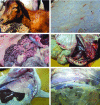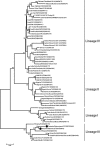Partial genetic characterization of peste des petits ruminants virus from goats in northern and eastern Tanzania
- PMID: 25135464
- PMCID: PMC4260210
- DOI: 10.1111/tbed.12229
Partial genetic characterization of peste des petits ruminants virus from goats in northern and eastern Tanzania
Abstract
Peste des petits ruminants (PPR) is an acute viral disease of small ruminants. The disease was first reported in Tanzania in 2008 when it was confined to the Northern Zone districts bordering Kenya. The present study was carried out to confirm the presence of PPR virus (PPRV) in Tanzania and to establish their phylogenetic relationships. Samples (oculonasal swabs, tissues and whole blood) were obtained from live goats with clinical presentation suggestive of PPR and goats that died naturally in Ngorongoro (Northern Tanzania) and Mvomero (Eastern Tanzania) districts. The clinical signs observed in goats suspected with PPR included fever, dullness, diarrhea, lacrimation, matting of eye lids, purulent oculonasal discharges, cutaneous nodules, erosions on the soft palate and gums and labored breathing. Post mortem findings included pneumonia, congestion of the intestines, and hemorrhages in lymph nodes associated with the respiratory and gastrointestinal systems. PPRV was detected in 21 out of 71 tested animals using primers targeting the nucleoprotein (N) gene. Phylogenetic analysis, based on the N gene, indicated that PPRV obtained from Northern and Eastern Tanzania clustered with PPRV strains of Lineage III, together with PPRV from Sudan and Ethiopia. The findings of this study indicate that there are active PPRV infections in Northern and Eastern Tanzania, suggesting risks for potential spread of PPR in the rest of Tanzania.
Keywords: Tanzania; nucleoprotein gene; peste des petits ruminants; peste des petits ruminants virus; phylogeny.
© 2014 The Authors. Transboundary and Emerging Diseases Published by Blackwell Verlag GmbH.
Figures



References
-
- Abraham G, Sintayehu A, Libeau G, Albina E, Roger F, Laekemariam Y, Abayneh D. Awoke KM. Antibody seroprevalences against peste des petits ruminants (PPR) virus in camels, cattle, goats and sheep in Ethiopia. Prev. Vet. Med. 2005;70:51–57. - PubMed
-
- Banyard AC, Parida S, Batten C, Oura C, Kwiatek O. Libeau G. Global distribution of peste des petits ruminants and prospects for improved diagnosis and control. J. Gen. Virol. 2010;91:2885–2897. - PubMed
-
- Couacy-Hymann E, Roger F, Hurard C, Guillou JP, Libeau G. Diallo A. Rapid and sensitive detection of peste des petits ruminants virus by a polymerase chain reaction assay. J. Virol. Methods. 2002;100:17–25. - PubMed
-
- Domenech J, Lubroth J, Eddi C, Martin V. Roger F. Regional and international approaches on prevention and control of animal transboundary and emerging diseases. Ann. N. Y. Acad. Sci. 2006;1081:90–107. - PubMed
-
- Forsyth MA. Barrett T. Evaluation of polymerase chain reaction for the detection and characterization of rinderpest and peste des petits ruminants viruses for epidemiological studies. Virus Res. 1995;39:151–163. - PubMed
Publication types
MeSH terms
Substances
Grants and funding
LinkOut - more resources
Full Text Sources
Other Literature Sources

